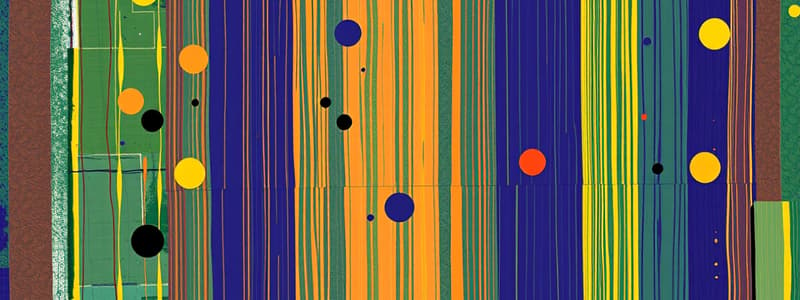Podcast
Questions and Answers
What is the purpose of f strings?
What is the purpose of f strings?
How to use f strings?
The Video explains the concept of __________ learning using linear regression as an example.
The Video explains the concept of __________ learning using linear regression as an example.
supervised
Linear regression is a widely used machine learning algorithm that fits a __________ line to the data to predict values based on one input.
Linear regression is a widely used machine learning algorithm that fits a __________ line to the data to predict values based on one input.
straight
Linear regression is a type of __________ model that predicts numbers as output.
Linear regression is a type of __________ model that predicts numbers as output.
There are other types of regression models and supervised learning models, such as __________ models, which predict categories.
There are other types of regression models and supervised learning models, such as __________ models, which predict categories.
The dataset used to train the model is called a __________ set, and the input is denoted by x and the output is denoted by y.
The dataset used to train the model is called a __________ set, and the input is denoted by x and the output is denoted by y.
Supervised learning algorithm inputs a dataset including both __________ features and __________ targets (right answers).
Supervised learning algorithm inputs a dataset including both __________ features and __________ targets (right answers).
The algorithm outputs a function () that takes a new input () and outputs an estimate (__________).
The algorithm outputs a function () that takes a new input () and outputs an estimate (__________).
The model makes predictions for () using a linear function of (), which is called linear regression with one variable ( ________ linear regression).
The model makes predictions for () using a linear function of (), which is called linear regression with one variable ( ________ linear regression).
For linear regression, the model is represented by ________.
For linear regression, the model is represented by ________.
Which of the following is the output or 'target' variable?
Which of the following is the output or 'target' variable?
The ________ function is a crucial element in making linear regression work.
The ________ function is a crucial element in making linear regression work.
How is y reflected in the code for linear regression?
How is y reflected in the code for linear regression?
What are the results of the given code snippet: x_train = np.array([1.0, 2.0])?
What are the results of the given code snippet: x_train = np.array([1.0, 2.0])?
To measure the model's performance, a ____________ function is used, which compares the ____________(y hat) to the ____________ (y) by taking the ____________ and ____________ it, then ____________ the squared errors across the ____________ training set and dividing by ____ the number of training examples (m).
To measure the model's performance, a ____________ function is used, which compares the ____________(y hat) to the ____________ (y) by taking the ____________ and ____________ it, then ____________ the squared errors across the ____________ training set and dividing by ____ the number of training examples (m).
The final cost function aims to find values for ____________ and ____________ that make the prediction y hat i close to the target y^i.
The final cost function aims to find values for ____________ and ____________ that make the prediction y hat i close to the target y^i.
代价函数(cost function)是用来评估算法__________与__________之间的差距的一种数学函数。
代价函数(cost function)是用来评估算法__________与__________之间的差距的一种数学函数。
J depends on the parameter ___ and controls the __________ of the line defined by fw.
J depends on the parameter ___ and controls the __________ of the line defined by fw.
When does the model fit the data relatively well?
When does the model fit the data relatively well?
What shape does the cost function J of w, b have?
What shape does the cost function J of w, b have?
Study Notes
Supervised Machine Learning: Regression and Classification
- Supervised learning utilizes input (x) and output (y) data to train models using known answers.
- Linear regression is a common technique that predicts numerical outcomes by fitting a straight line to data.
- There are multiple regression models, with classification models specifically predicting categorical outcomes.
Data Fundamentals
- The training set is the dataset used to train the model, while the input features are represented as x and the output targets as y.
- The algorithm operationalizes predictions through a function denoted as f(x), which estimates outputs (y-hat) based on new inputs.
Model Functionality
- Linear regression can be expressed mathematically as fw,b(x) = wx + b, where w represents slope and b represents the intercept.
- The performance of the model is assessed using a cost function, which compares predicted values (y-hat) to actual targets (y).
Cost Functions
- The cost function quantifies the prediction error by summing the squared differences between y-hat and y across the training set, averaging this sum over the number of training examples.
- The objective of the cost function is to minimize the error by optimizing the parameters w and b, ensuring that y-hat closely approximates y.
Visualization and Analysis
- The shape of the cost function is typically represented in three dimensions resembling a soup bowl or hammock, indicating minima that reveal optimal parameter values.
- When the cost is minimized, the model effectively captures the underlying data trends, making accurate predictions.
Practical Example
- For instance, if x_train = np.array([1.0, 2.0]), the array will consist of elements reflecting those inputs, and operations can be performed to calculate the model output using the defined function.
- Implementing a cost function involves squaring the differences between predictions and actual values, aiding in the evaluation and refinement of model accuracy.
Studying That Suits You
Use AI to generate personalized quizzes and flashcards to suit your learning preferences.
Description
These flashcards cover key concepts from the first week of supervised machine learning, focusing on regression and classification techniques. Explore definitions and examples, including the use of f-strings in Python and the fundamentals of linear regression. Perfect for students beginning their journey into machine learning.




